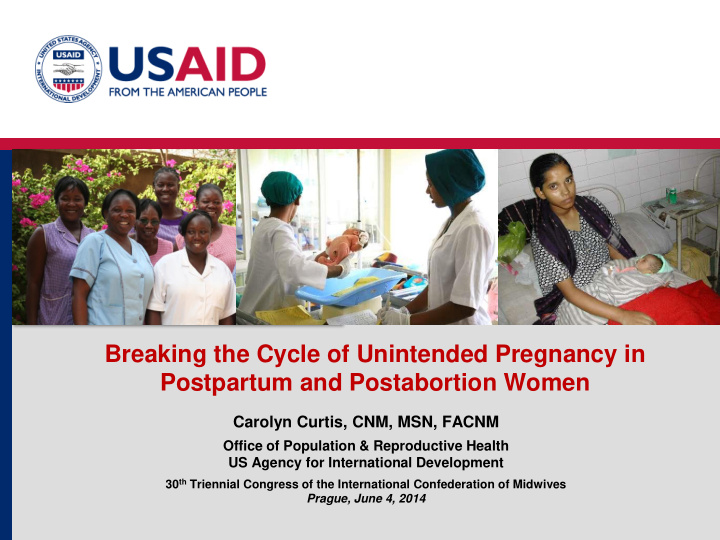



Breaking the Cycle of Unintended Pregnancy in Postpartum and Postabortion Women Carolyn Curtis, CNM, MSN, FACNM Office of Population & Reproductive Health US Agency for International Development 30 th Triennial Congress of the International Confederation of Midwives Prague, June 4, 2014
Overview Barriers Postpartum Women Postabortion Women How to overcome “missed opportunities ”
Barriers to FP services for postpartum and postabortion (PAC) clients Outcomes when barriers Barriers are overcome: Structure of ↑ ↑ Access services Myths and misperceptions ↑ ↑ Quality of services Exaggerated provider concerns Inappropriate ↑ ↑ Choice and use (re STI, PID, infertility, eligibility expulsion) criteria ↓ ↓ Rapid repeat pregnancy Provider bias Stigma ↓ ↓ Abortion Lack of knowledge re: Where births return to fertility occur Poor CPI Lack of skills Source: RESPOND Project, 2012.
Family planning programs: What has worked? Ten Essential Elements Selected, High-Impact Practices (HIPs) of Successful FP Programs 1. Supportive Policies • Community-based services & task-shifting / task-sharing 2. Evidence Based Programming 3. Strong Leadership and Good • Postpartum FP Management • Postabortion FP (PAC) 4. Effective Communication Strategies • Mobile outreach services 5. Contraceptive Security 6. High Performing Staff 7. Client-Centered Care 8. Easy Access To Services 9. Affordable Services 10. Appropriate Integration of Services Source: Population Reports 2008, JHU.
Who are the women? 1 in 4 women in developing countries have an unmet need for FP = 222 MILLION women with unmet need! Each year: 210 million pregnancies 80 million unintended pregnancies 44 million abortions 31 million stillbirths Approximately 130 million births = 130 million postpartum women
Reproductive intentions of postpartum women – 12 months following a birth 100% 95% 80% 65% 60% 40% 30% 20% 5% 0% Want to give Want to space Using FP Not using a birth in 2 years or limit method method Source: Ross and Winfrey “Contraceptive use, Intention to use, and unmet need during the extended postpartum period, Intl FP Perspectives, 2001. Analysis of DHS data from 27 countries
Unmet need, contraceptive use & reproductive intention in women 0-12 months postpartum 100 90 80 74 70 65 62 60 54 52 50 44 42 40 32 29 30 18 20 8 10 5 4 4 3 0 Global Sub-Saharan Middle East Asia Latin America Africa % Unmet Need % Using Method - Modern & Traditional % Desiring birth within 2 years Source: Ross, J, Winfrey, W, Contraceptive Use, Intention to Use and Unmet Need During the Extended Postpartum Period, International Family Planning Perspectives, 2001 27(1) 20-27.
Postpartum FP use and method mix among women giving birth in previous 12 months 100 90 80 70 62 76 77 78 77 60 83 87 87 92 50 40 30 20 10 0 Permanent method LARCs Short-acting resupply Traditional method Not using Source: RESPOND Project, secondary analysis of respective DHS, 2010.
2014 State of the World Midwifery Report Number of countries with regulations allowing midwives to provide family planning Type of Contraceptive 80 70 70 65 60 50 40 30 20 10 0 0 Injectables Implants IUD Implants not included on questionnaire
PAC FP: background 26% of the world’s 7 billion people are aged 10 -24 FP demand in young and unmarried women is high, but access is constrained: 50-80% demand among married women age 15-24; 20-40% unmet need ~ 90% of unmarried women 15-24 in all regions of the world do not want to become pregnant, but their unmet need is very high, approaching 50% in some sub-Saharan African countries Complications of unsafe abortion are a main cause of death in 15-19 year-old women in low-resource countries A considerable problem in the U.S. too: The American College of Obstetricians and Gynecologists recommends that its members “ encourage adolescents age 15-19 to consider implants and IUDs as the best reversible methods for preventing unintended pregnancy, rapid repeat pregnancy, and abortion in young women.” - - ACOG Committee Opinion #539, Obstet. Gynecol., 2012; 120(4):983-988
PAC FP: How we fail women 100 80 77% 60 60% 40 32% 20 20% 0 Using FP before pregnancy (method failure) Desire to space or limit next pregnancy Desired a FP method before leaving facility Left facility with FP method Source: Situation Analyses in Haiti, Dominican Republic, & Nicaragua. Population Council, 2008
Impact of decentralizing PAC services to lower-level fixed sites PAC Clients, 21 Districts in Tanzania (October 1, 2007 - September 30, 2010) Results: Decentralized PAC services PAC Clients 17,262 in 21 districts 293 health care workers trained Counseled on FP 14,737 FP counseling and services in 224 sites Accepted 12,106 Source: ACQUIRE Tanzania Project 0 5,000 10,000 15,000 20,000 Number of PAC clients
Joint Statements by: FIGO ICM ICN DFID Gates White Ribbon Alliance Others to advance postpartum and postabortion FP
What is needed to ensure “No missed o pportunity”? National Level Facility Level Ensure the latest WHO FP Ensure contraceptive supply service delivery guidelines are in place – and model Make FP & LA/PMs available following them in practice and at reduced cost or free Reorganize services to Support proven policy ensure FP services at same changes for midlevel location (PP, PAC, EMOC). providers Become a visible “champion” Include FP in pre-service in your facility for increasing curricula & certifying exams FP availability and access. Change in the WHO MEC for postpartum women
Thank You!!! Photo credits: Slide 1 (left to right), A. Jackson/EngenderHealth; A. Fiorente/EngenderHealth; C. Svingen/EngenderHealth. Slide 5 (top to bottom), M. Tuschman/EngenderHealth; C. Svingen/EngenderHealth; M. Tuschman/EngenderHealth; E. Uphoff/EngenderHealth.
Recommend
More recommend